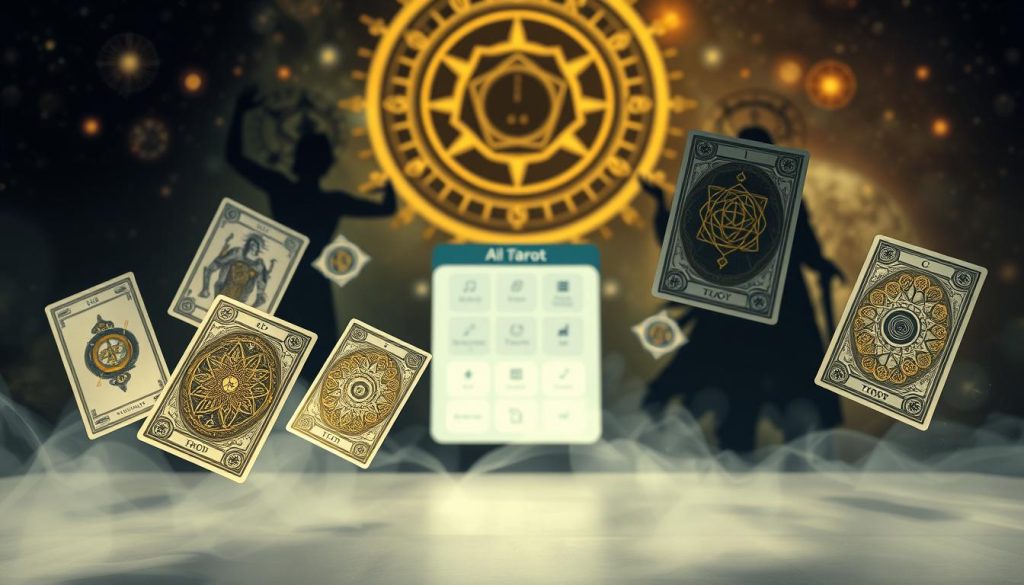We set our compass for a gentle meeting where archetypes and code sit side by side. We invite curious minds to walk with us as practices evolve across years of fast change.
Here we honor divination as a living craft while exploring tools that widen access and deepen wisdom. Expect new experiences like immersive sessions, subscription offerings, and smart helpers that learn language used in readings.
We ask careful questions: how do we keep soul in a landscape shaped by artificial intelligence? Thought leaders urge both excitement and caution about hallucination, projection, and clear framing.
Join us as co-explorers. This is a shared adventure toward accessible learning, personal growth, and ethical guardrails that let mystery stay luminous in our world.
From esoteric origins to digital decks: how traditional tarot laid the groundwork for AI
Long before code, hands and stories shaped meanings; those patterns still guide digital tools today. Traditional tarot built a living grammar: layered imagery, named positions, and repeatable spreads that teach readers how to tell a story from many cards.

Symbolism, spreads, and the human reader’s role in interpretation
Symbolism gives each tarot card rich, archetypal depth. A single image can hold multiple possible paths depending on context and timing.
Spreads act like maps. Position and relation shape interpretation. A skilled reader blends knowledge, intuition, and ethics to surface meaning.
Language around meanings has always shifted. In our world, digital text and recorded readings accelerate that change. AI models learn patterns from this growing archive, but they lack the felt presence that a reader brings.
We celebrate tradition while asking how systems can assist without flattening nuance. Responsible innovation keeps the human role central, letting technology support careful, soulful tarot reading.
AI is reshaping tarot right now: accessibility, personalization, and new learning paths
Apps and platforms make guidance instant. We can pull cards at 2 a.m. or between calls. That always-on access lets questions get answered when they feel most urgent.
Natural language tools tune into user tone and intent. NLP helps reading sessions respond with kinder, tailored insights. Past interactions shape follow-up suggestions so each session feels personal.
Learning tools gamify practice. Bite-sized tutorials, simulated shuffles, and instant feedback help beginners build confidence with spreads and meanings. Streaks and playful prompts make study feel light and steady.
Practitioners also benefit. Systems draft spreads, manage bookings, and store client notes so readers reclaim presence and care. Platforms widen reach, turning solo pulls into community moments.
We celebrate ai-powered tarot features while urging discernment. Tools can suggest cards and draft interpretations, but guidance stays a human bond. Use tech for setup and outreach; keep meaning-making human.
The AI tarot platform landscape: tools, experiences, and who they’re for
New tools are carving distinct paths for quick pulls, deep rituals, and social exchange in tarot practice. We explore five standout platforms so readers can match their intent with the right system.

Tarota AI
Tarota AI adapts meanings to user input. It supports multiple spreads, from single-card nudges to a full Celtic Cross. The mobile-ready design helps daily ritual feel calm and steady.
StarGuide AI
StarGuide AI ties draws to zodiac cycles and planetary timing. Seekers who follow astrology get layered themes that link transit energy with a tarot card’s message.
Tarotap
Tarotap strips back friction. Quick, clean draws help beginners and busy users ask fast questions and get an immediate reading without overwhelm.
TarotNova AI
TarotNova AI blends AI with community interpretations. Users build custom layouts, share meanings, and receive live feedback that sharpens understanding through dialogue.
TarotBot
TarotBot runs a chat-based flow with real-time answers and gamified streaks. It’s playful and social, nudging regular practice through rewards and conversational prompts.
Choosing a platform depends on your goal. Want quick clarity? Try Tarotap. Craving cosmic timing? StarGuide helps. Prefer community learning? TarotNova fits well. Sampling a few systems clarifies which tools suit your style and themes.
The Future of Tarot: From Ancient Decks to AI-Powered Readings across 10, 20, and 50 years
Watch as floating archetypes and smart systems redraw what a small ritual can mean in daily life.

Near horizon (about 10 years)
VR/AR sessions will make cards hover in calm rooms. Subscription models will fund steady practice and gentle coaching. Experimental models may even explore financial contexts with care and ethics.
Mid-range (around 20 years)
We expect global reader networks where anonymous shares build collective wisdom across borders.
Tarot life coaches will use systems that track progress over time, tuning plans after each pull. Metaverse rooms will host classes, shops, and group rituals.
Distant horizon (50 years and beyond)
Speculative tools include neural interfaces that deepen symbolic immersion and IoT devices that surface a tarot card when timing calls for it.
Quantum links might carry layered meaning across space. New tarot artifacts—holographic decks, eco materials, and multi-sensory experiences—will keep practice tactile and visionary.
We balance wonder with responsibility. Consent-first design, transparent methods, and clear guidance will matter as divination meets artificial intelligence. Join us: test, reflect, and help shape these years ahead.
Ethics, authenticity, and the human mirror: navigating AI tarot responsibly
Let’s look closely at how meaning can wobble when a smart system speaks like a sage. Natural language models can craft fluent text that feels deep but may invent facts.
Hallucination and projection are twin risks. A reader or practitioner should treat AI outputs as prompts, not gospel. Invite questions. Pause before accepting a confident interpretation.
Disclaimers matter. Flag when interpretations are symbolic, speculative, or for entertainment. This honors consent and helps users set expectations.
Transparency and privacy build trust. Declare what data the system uses, how interpretations form, and how client notes stay private. Simple language works best.
We call for community standards. Shared guidelines help keep readings compassionate and safe. Practitioners should check interpretations, invite dialogue, and slow down when depth is needed.
Finally, design sessions with rituals: a breath, a pause, journaling after insights. Time helps wisdom settle and separates real guidance from noise.
Charting a mindful path forward: blending tradition, community, and intelligent tools
Balance matters: keep hands on cards and use platforms to widen access, not replace wisdom.
We blend tradition with helpful tools. Let archetypes and spreads lead while systems handle logistics. This keeps ritual honest and simple.
Build community spaces for sharing interpretations, group readings, and steady learning. Invite feedback and gentle critique. That grows shared knowledge over time.
Practitioners should add clear disclaimers, privacy-first rules, and referral paths for deeper support. Small rituals — slow shuffles, a breath, a quick journal entry — help insights land.
Try a platform that fits your style, refine your tarot reading with practice, and hold space for new tarot forms that honor the craft. Let’s explore together, curious and kind.
